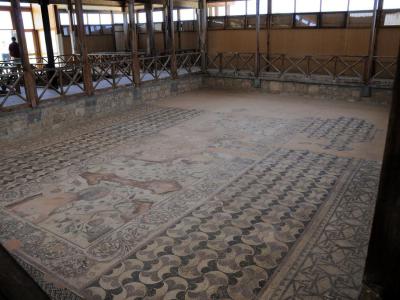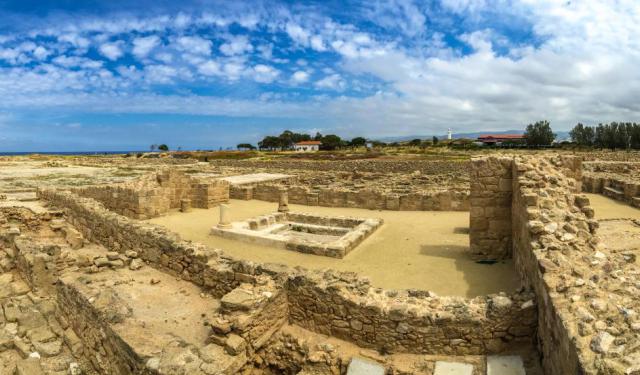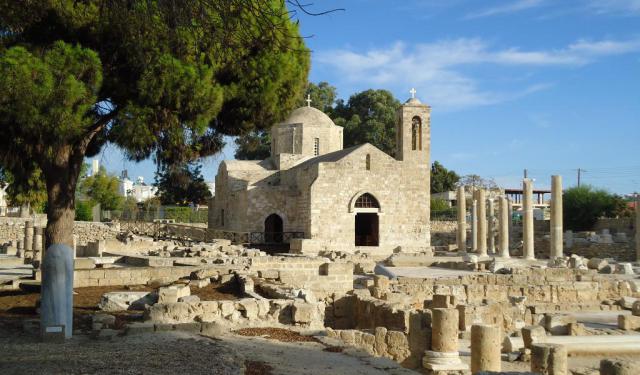
The House of Dionysus, Paphos (must see)
The House of Dionysos, a prominent feature of the Paphos Archaeological Park in Cyprus, is one of four Roman villas renowned for their exquisite floor mosaics. These Roman villas are collectively known as the Mosaic Houses, each adorned with intricately crafted mosaics that provide a fascinating glimpse into the art and culture of the period.
The House of Dionysos is celebrated for its remarkable floor mosaics that grace its interior. These mosaics, meticulously composed of limestone tiles, are believed to have been created during the second and third centuries AD. Intriguingly, these intricate artworks remained hidden from view until 1962 when a local farmer stumbled upon them.
This extraordinary villa, which occupies a total area of 2000 square meters, is named after the Greek god Dionysos. The god Dionysos is a recurring theme in many of the mosaics found within the villa. These mosaics depict scenes from mythology, history, and hunting, and they offer valuable insights into the cultural and artistic influences of the time.
The House of Dionysos features a well-planned architectural layout. Its rooms are organized around a central courtyard, known as an atrium, which served as the heart of the villa. This central space was not only aesthetically pleasing but also functioned as a hub for various activities within the house.
The villa's construction dates back to the end of the 2nd century AD, representing a significant period of Roman rule in Cyprus. However, the villa's decline and eventual abandonment were prompted by a series of devastating earthquakes in the 4th century AD. These natural disasters led to the villa's structural damage and its eventual abandonment.
Beneath the House of Dionysos, evidence of an earlier villa from the 3rd century BC has been discovered. This villa is particularly notable for its Hellenistic pebble mosaic that portrays the mythical sea-monster Scylla. This ancient mosaic has been preserved in its original location, offering a unique opportunity to observe the historical and artistic transition between different periods.
The House of Dionysos, along with the other Mosaic Houses in the area, stands as a testament to the opulence and cultural sophistication of the Roman era in Paphos. The well-preserved mosaics are a vivid representation of the artistic achievements and interests of the time, allowing modern visitors to step back in history and appreciate the enduring beauty of these ancient works of art.
The House of Dionysos is celebrated for its remarkable floor mosaics that grace its interior. These mosaics, meticulously composed of limestone tiles, are believed to have been created during the second and third centuries AD. Intriguingly, these intricate artworks remained hidden from view until 1962 when a local farmer stumbled upon them.
This extraordinary villa, which occupies a total area of 2000 square meters, is named after the Greek god Dionysos. The god Dionysos is a recurring theme in many of the mosaics found within the villa. These mosaics depict scenes from mythology, history, and hunting, and they offer valuable insights into the cultural and artistic influences of the time.
The House of Dionysos features a well-planned architectural layout. Its rooms are organized around a central courtyard, known as an atrium, which served as the heart of the villa. This central space was not only aesthetically pleasing but also functioned as a hub for various activities within the house.
The villa's construction dates back to the end of the 2nd century AD, representing a significant period of Roman rule in Cyprus. However, the villa's decline and eventual abandonment were prompted by a series of devastating earthquakes in the 4th century AD. These natural disasters led to the villa's structural damage and its eventual abandonment.
Beneath the House of Dionysos, evidence of an earlier villa from the 3rd century BC has been discovered. This villa is particularly notable for its Hellenistic pebble mosaic that portrays the mythical sea-monster Scylla. This ancient mosaic has been preserved in its original location, offering a unique opportunity to observe the historical and artistic transition between different periods.
The House of Dionysos, along with the other Mosaic Houses in the area, stands as a testament to the opulence and cultural sophistication of the Roman era in Paphos. The well-preserved mosaics are a vivid representation of the artistic achievements and interests of the time, allowing modern visitors to step back in history and appreciate the enduring beauty of these ancient works of art.
Want to visit this sight? Check out these Self-Guided Walking Tours in Paphos. Alternatively, you can download the mobile app "GPSmyCity: Walks in 1K+ Cities" from Apple App Store or Google Play Store. The app turns your mobile device to a personal tour guide and it works offline, so no data plan is needed when traveling abroad.
The House of Dionysus on Map
Sight Name: The House of Dionysus
Sight Location: Paphos, Cyprus (See walking tours in Paphos)
Sight Type: Attraction/Landmark
Guide(s) Containing This Sight:
Sight Location: Paphos, Cyprus (See walking tours in Paphos)
Sight Type: Attraction/Landmark
Guide(s) Containing This Sight:
Walking Tours in Paphos, Cyprus
Create Your Own Walk in Paphos
Creating your own self-guided walk in Paphos is easy and fun. Choose the city attractions that you want to see and a walk route map will be created just for you. You can even set your hotel as the start point of the walk.
Paphos Archaeological Park Walking Tour
Paphos is divided into two parts. Kato Paphos, the area near the harbor, is where all the archaeological sites are located, while Ktima (Old Town) is where you'll find the museums. The Archaeological Park of Kato Paphos has been included in the UNESCO World Heritage Sites list since 1980.
This park includes sites and monuments from the 4th century BC to the Middle Ages, while most remains... view more
Tour Duration: 1 Hour(s)
Travel Distance: 2.0 Km or 1.2 Miles
This park includes sites and monuments from the 4th century BC to the Middle Ages, while most remains... view more
Tour Duration: 1 Hour(s)
Travel Distance: 2.0 Km or 1.2 Miles
Paphos Introduction Walking Tour
For most people, the mesmerizing town of Paphos on the southwestern coast of Cyprus is all about sun, sand, and sea. However, alongside its beachy vibes, this seaside resort is home to a swag of important historical tourist attractions that contributed to Paphos being anointed European Capital of Culture in 2017.
Indeed, as a UNESCO World Heritage-listed city, Paphos is steeped in both... view more
Tour Duration: 2 Hour(s)
Travel Distance: 4.1 Km or 2.5 Miles
Indeed, as a UNESCO World Heritage-listed city, Paphos is steeped in both... view more
Tour Duration: 2 Hour(s)
Travel Distance: 4.1 Km or 2.5 Miles


